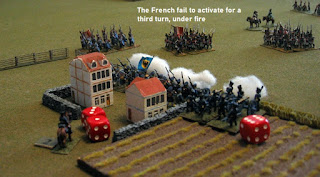I played a solo game of the scenario today. Fast? You bet, 75 minutes, 7 turns. There were 4 French regular battalions and a battery vs. 3 Landwehr battalions (1 militia status) and a battery. It was 58 French points to 30 Prussian points. The result shows the discrepancy.
Units become wavering after taking
hits = to their tenacity. Brigades waver after having 3 setbacks (units waver and/or
rout). Additional hits make wavering units take Valour tests. Failure means rout and removal. Additional setbacks make wavering
brigades take Fortitude tests, failure resulting in the brigade’s removal from
the game. The rules were designed for a larger game than this (as were Shadow
of the Eagles in the previous solo game). In a normal game, the army CO can get
one brigade to activate automatically. I decide to dispense with this and have
both sides test their individual brigades to activate. Without this the game
would have been over 3 turns sooner. This was my first time trying the rules on
the table. Each turn, each player draws a fate card (from standard poker
cards). The cards add some flavor to the proceedings. On to the game.
Some of the text on the next photo is wrong: I did use the right number of melee dice for the French. Errors in photo text are most apparent after hitting save.
The game was fast. I like the
rapid movement – no more “we should have started the two sides closer”. It is very easy to mass them as they advance. The rules say attacking units can get
support. A French regular battalion has 4 melee dice, plus 1 for attack column,
+2 for a flank support, +1 for a brigade rear support gives 8 dice. The odds
call for 4 hits. This will force anything less than regular troops to take a
Valour test. If the target has been softened up at all, regular units will also
test. Hits scored by the enemy will be spread among the attackers and supports.
It seems in a large game the attack will often break the line. The riposte to
that must be counterattacks by reserves.
The previous game with Shadows of
the Eagles (full disclosure: I helped game-test the rules on this side of the pond)
saw the French brigade break one Prussian battalion and evict the Prussians
from the town, but taking enough damage that they were incapable of pursuit and
needed a bit of time to recover from the fray. A new enemy force would have
them at a severe disadvantage right then.
This V&F game saw two
Prussian units routed and one French. If the French had not failed to activate,
the game would have been over 3 turns sooner, an easy victory. The French were capable of pursuit
but probably should take a turn or two to adjust their lines in case of a
potential counterattack.
I would have to see how V&F works for a larger game before coming to a final decision. It certainly is fast. I do like the fate cards.
Normally I use 12 figure battalions in a single rank. With so few units on the table I opted for more figures two bases deep.
If you want to see the Valour & Fortitude rules, click here.












1 comment:
An interesting replay. I think the soul of the rules is that in a big game, a failing brigades exit can be swift and so multi brigade games come in within typical single sessions, such as club night. I noted the same as you, that with Shadow of the Eagles, a unit can typically do one thing and then it is done for a while (i.e.needs to recover from weakened) and so is vulnerable to a new contact. I quite like the way that encourages reserves or attacks renewed by other units.
Post a Comment